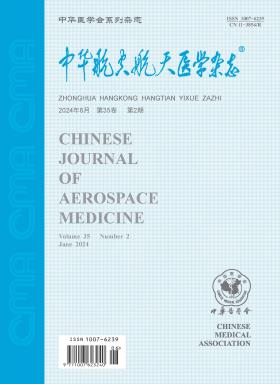Study on applying gradual-onset rate mode in acceleration tolerance determination
引用次数: 0
Abstract
Objective To study the gradual-onset rate (GOR) mode on human centrifuge G-tolerance determination and the applications in pilot selection and training. Methods Twenty-five pilots were undertaken the G-tolerance examination under centrifuge GOR operating mode and completed high G centrifuge training at + 8.0 Gz level for 10 s. The pilots were divided into excellent group (n=13), good group (n=7) and mediocre group (n=5) by the high G training result. The pilots, G-tolerance under GOR mode and the anti-G effect of performing HP maneuver were analyzed. Results Under GOR mode pilots, strained tolerance (GOR2) was significantly higher than their relaxed tolerance (GOR1) (t=14.420, P=0.000). The differences on GOR1 tolerance and HP maneuver anti-G effect were not significant among different groups (F=2.593, 0.176, P>0.05). The GOR2 tolerance of excellent group was significantly higher than that of other 2 groups (P 0.05). Conclusions The G-tolerance and the effect of performing anti-G straining maneuver could be precisely and conveniently evaluated with GOR mode. It is necessary to establish the G-tolerance examination method and assessment criterion under centrifuge GOR mode for the G tolerance determination and training of high performance fighter aircraft pilot. Key words: Acceleration; Centrifuge; gradual-onset rate; relaxed G tolerance; Anti-G training渐起率模型在加速度公差确定中的应用研究
目的探讨人体离心机g -耐量测定的渐起率(GOR)模式及其在飞行员选拔和培训中的应用。方法对25名飞行员在离心机GOR操作模式下进行G容差检查,并在+ 8.0 Gz水平下进行10 s高G离心训练。根据高G训练结果将飞行员分为优秀组(n=13)、优秀组(n=7)和一般组(n=5)。分析了GOR模式下飞行员的g容限和HP机动的反g效应。结果GOR模式下飞行员的紧张耐受性(GOR2)显著高于放松耐受性(GOR1) (t=14.420, P=0.000)。各组间GOR1耐受性和HP机动抗g效应差异无统计学意义(F=2.593、0.176,P>0.05)。优秀组的GOR2耐受性显著高于其他2组(P < 0.05)。结论GOR模型可以准确、方便地评价大鼠的g耐受性和抗g应变动作的效果。建立离心机GOR模式下的G容差检测方法和评定标准,是高性能战斗机飞行员G容差确定和训练的必要条件。关键词:加速度;离心机;逐渐发生率;放宽G公差;Anti-G培训
本文章由计算机程序翻译,如有差异,请以英文原文为准。
求助全文
约1分钟内获得全文
求助全文
来源期刊

中华航空航天医学杂志
航空航天医学
自引率
0.00%
发文量
2962
期刊介绍:
The aim of Chinese Journal of Aerospace Medicine is to combine theory and practice, improve and popularize, actively advocate a hundred flowers bloom and a hundred schools of thought contend, advocate seeking truth from facts, promote the development of the related disciplines of aerospace medicine and human efficiency, and promote the exchange and penetration of aerospace medicine and human efficiency with other biomedical and engineering specialties.
Topics of interest for Chinese Journal of Aerospace Medicine include:
-The content of the journal belongs to the discipline of special medicine and military medicine, with the characteristics of multidisciplinary synthesis and cross-penetration, and mainly reflected in the aerospace industry, aerospace flight safety and efficiency, as well as the synthesis of special medicine, preventive medicine, environmental medicine, psychology, etc.
-Military aeromedicine (Air Force, Navy and Army aeromedicine) and civil aeromedicine, with a balance of aerospace medicine are the strengths of the journal.
-The change in aerospace medicine from a focus on promoting physiological compensatory adaptations to enhancing human performance under extreme environmental conditions is what the journal is helping to promote.
-The expansion of manuscripts in high altitude medicine is also a special emphasis of the journal.
 求助内容:
求助内容: 应助结果提醒方式:
应助结果提醒方式:


